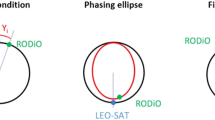Abstract
On June 21, 2010 the TanDEM-X satellite (TDX) was injected into orbit at 15,700 km distance from its twin satellite TerraSAR-X (TSX), which has been in orbit since 2007. Already one month later TDX acquired a formation with TSX in order to build up the first single-pass radar interferometer in space. Within three years of close formation flying with flexible baselines ranging from 150 m to a few kilometers the twin satellites will collect interferometric radar measurements for the generation of a global digital elevation model with unprecedented accuracy. This paper elaborates on the TDX pre-launch analysis performed in the fields of collision assessment during orbit injection and target formation acquisition. To avoid a critical close approach shortly after TDX separation, the risk of collision between the already flying TSX satellite and the newly injected elements (DNEPR upper-stage, gas dynamic shield, and TDX satellite) had to be carefully analyzed. Further, the paper discusses a fuel-saving formation acquisition strategy, for which the maneuver budget is analyzed as a function of launch day and launch injection accuracy. Finally, flight results are presented to illustrate the successful formation acquisition realized in July 2010 and the formation reconfiguration process from the 20 km wide formation into the 300–400 m close formation performed in October 2010. This reconfiguration marked the start of the bi-static TDX/TSX instrument operation.







Similar content being viewed by others
Notes
Remark: Although a small adjustment of the launch time depending on the cycle-day would be beneficial in terms of RAAN correction (e.g. a 1 s change translates into a 0.1 deg RAAN change) this option was not implemented in order to ease interface specifications with the launch provider.
Note that the analysis was initially performed for the launch into 5 km higher altitude (i.e. TSX altitude). Here the probabilities for collision of TSX and GDS were significantly larger and radial distances below 100 m were found.
The start of the commissioning phase was foreseen on cycle-day 1 within 3 cycles after TDX launch.
Note that we consider day 6 as compliant too, because the maximum maneuver budget for the 1-σ dispersion exceeds the 18.5 m/s limit by less than 1 %.
The relative SMA is nominally zero for all formations.
References
Gill, E., D’Amico, S., Montenbruck, O.: Autonomous formation flying for the PRISMA mission. J. Spacecr. Rocket. 44(3), 671–681 (2007)
Krieger, G., Moreira, A., Fiedler, H., Hajnsek, I., Werner, M., Younis, M., Zink, M.: TanDEM-X: A satellite formation for high-resolution SAR interferometry. IEEE Trans. Geosci. Remote Sens. 45(11), 3317–3341 (2010)
Moccia, A., Fasano, G.: Analysis of spaceborne tandem configurations for complementing COSMO with SAR interferometry. EURASIP J. Appl. Signal Process. 20, 3304–3315 (2005)
Schättler, B., Kahle, R., Metzig, R., Balzer, W., Zink, M.: “Extending the TerraSAR-X Ground Segment for TanDEM-X,” 8th European Conference on Synthetic Aperture Radar, EUSAR 2010. Germany (2010)
Montenbruck, O., Kahle, R., D’Amico, S., Ardaens, J.S.: Navigation and control of the TanDEM-X formation. J. Astronaut. Sci. 56(3), 341–357 (2008)
Kahle, R., Schlepp, B.: “Extending the TerraSAR-X Flight Dynamics System for TanDEM-X,” Proceedings of the 4th International Conference on Astrodynamics Tools and Techniques. Spain (2010)
Montenbruck, O., D’Amico, S.: Proximity operations of formation-flying spacecraft using an eccentricity/inclination vector separation. J. Guid. Control. Dyn. 29(3), 554–563 (2006)
Eckstein, M.C., Rajasingh, C.K., Blumer, P.: “Colocation Strategy and Collision Avoidance for the Geostationary Satellites at 19 Degrees West,” Proceedings of the 5th International Symposium on Space Flight Dynamics, Toulouse, France (1989)
D’Amico, S., Arbinger, C., Kirschner, M., Campagnola, S.: “Generation of an Optimum Target Trajectory for the TerraSAR-X Repeat Observation Satellite,” Proceedings of the 18th International Symposium on Space Flight Dynamics, Munich, Germany (2004)
Kahle, R., Kazeminejad, B., Kirschner, M., Yoon, Y., Kiehling, R., D’Amico, S.: “First In-Orbit Experience of TerraSAR-X Flight Dynamics Operations,” Proceedings of the 20th International Symposium on Space Flight Dynamics, Annapolis, USA (2007)
Patera, R.P.: General method for calculation of satellite collision probability. J. Guid. Control. Dyn. 24(4), 716–722 (2001)
Klinkrad, H.: Space Debris–Models and Risk Analysis, Springer-Verlag, ISBN 978-3-540-25448-5 (2006)
Vallado, D.: Fundamentals of Astrodynamics and Applications, Space Technology Library, ISBN 1- 881883-12-4 (2001)
Kahle, R., Schlepp, B., Kirschner, M.: “TerraSAR-X/TanDEM-X Formation Control–First Results from Commissioning and Routine Operations,” Proceedings of the 22nd International Symposium on Space Flight Dynamics, Brazil (2011)
Acknowledgments
The TanDEM-X project is partly funded by the German Federal Ministry for Economics and Technology (Förderkennzeichen 50 EE 0601) and is realized in a public-private partnership (PPP) between German Aerospace Center (DLR) and Astrium GmbH.
Author information
Authors and Affiliations
Corresponding author
Electronic supplementary material
Below is the link to the electronic supplementary material.
ESM 1
(PDF 12860 kb)
Rights and permissions
About this article
Cite this article
Kahle, R., Schlepp, B., Meissner, F. et al. The TerraSAR-X/TanDEM-X Formation Acquisition–from Planning to Realization. J of Astronaut Sci 59, 564–584 (2012). https://doi.org/10.1007/s40295-014-0003-3
Published:
Issue Date:
DOI: https://doi.org/10.1007/s40295-014-0003-3



